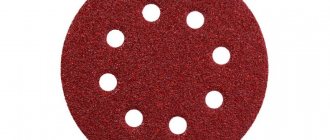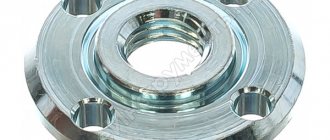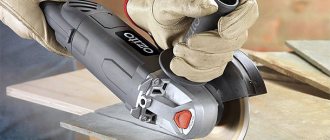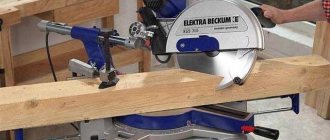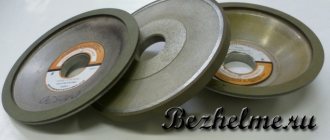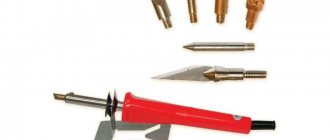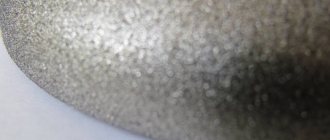What are diamond wheels for metal used for?
Diamond grinding wheels are one of the types of diamond tools. These devices are used to equip machines and electrical equipment. Diamond wheels are rarely used for manual operations.
Photo No. 1: diamond grinding wheels for metal
The main areas of application of these devices are machine tool and mechanical engineering. More highly specialized areas of use include:
- medicine;
- instrument making;
- production of porcelain, glass and crystal products;
- dentistry (dental prosthetics).
The following basic operations are performed using diamond wheels for metal.
- Sharpening of parts and tools (incisors, scalpels, knives, etc.).
- Honing.
- Finishing.
- Grinding.
- Polishing.
- Rip-off.
- Rough finish.
Most often, diamond wheels are used for processing workpieces and products from:
- hard alloys and other difficult-to-process materials;
- glass;
- ceramics.
In addition, semi-precious, semi-precious and precious stones are processed with diamond wheels.
Peculiarities
Diamond blades are not only highly efficient and long lasting, but also self-sharpening, combined with a perfect balance between strength and brittleness. The tool is used not only in industry, but also in everyday life.
The discs themselves are made of aluminum alloys or steel. A thin layer of a special composition of bakelite resin with the addition of diamond chips of various fractions is applied to the surface of the workpieces. It should be noted that so far the industry has not invented anything that is superior in hardness to the diamond version of the abrasive. The closest value is only cubic boron nitride - borazone, elboron. The remaining abrasive substances are not at all competitors in the processing of ferrites, metal-ceramic composite and other hard-alloy materials.
Design and common shapes of diamond wheels
Let's tell you more about the design of a diamond wheel. Its main part is a durable disk with a hole.
Image #1: Diamond wheel design
Discs are made from materials of two groups.
- Structural steels (St20, St3, etc.). Discs made of these materials are characterized by increased resistance to mechanical loads and vibrations. Steels dissipate heat well.
- Aluminum alloys (D16 and AK group alloys). They have excellent thermal conductivity, but less strength. When processing workpieces at high speeds, discs of these materials are prone to vibration.
- Composite materials with the addition of polymers. Discs made from them are characterized by maximum vibration resistance, but strength and thermal conductivity leave much to be desired.
Some surfaces of the disk (1 more) are covered with a working layer. It includes:
- filler (this is powder made from boron carbide, electrocorundum, alumina, copper or graphite);
- ligament;
- diamond powder.
It is the working layer that comes into contact with the workpiece during processing.
Features of ligaments
In the manufacture of diamond wheels for metal, three types of bonds are used.
1. Bundles on metal bases. The latter include composites of zinc, aluminum, copper and tin. Metal bundles:
- are characterized by maximum strength;
- have high heat resistance;
- when used, the instruments do not become deformed for a long time;
- serve for a long time;
- quickly pickled;
- increase the productivity of diamond wheels for metal.
Tools with such bonds are used to remove large amounts of metal from workpieces. The main operation is pre-processing. The resulting surface acquires an eighth-ninth class of roughness.
2. Organic ligaments. They have low strength and heat resistance. Productivity and processing speed are at a high level. The tools are little greasy, but the working surfaces wear out quickly due to the increased consumption of diamonds.
Diamond wheels for metal with organic bonds are used when processing workpieces made from the following materials.
- Hard alloys.
- Difficult to process materials.
- Metals intended for the manufacture of medical and measuring instruments.
The main operations are finishing, finishing, high-quality sharpening. The roughness class of the resulting surfaces is 11 or 12.
3. Ceramic bonds. The circles with them have a diamond-nickel coating. It is applied in one or several layers. Let us list the key characteristics of tools in this category.
- High cutting ability.
- Low price.
- Excellent thermal conductivity.
- High-quality removal of chips from machined surfaces.
Such diamond wheels for metal are used for processing workpieces from:
- germanium, sital, silicon and other semiconductor materials;
- stone;
- ceramics;
- technical glass.
The main operations are cutting and finishing.
Shapes of diamond wheels for metal
Most often, 8 types of diamond wheels for metal are used.
- Flat circles without grooves (D/N >= 1.8).
- Rings (D/N ˂ 1.8).
- Flat circles with one-sided relief.
- Flat cone-shaped models.
- Flat circles with one recess.
- Flat circles with two grooves.
- Cup circles (45° ˂ α ˂ 90°).
- Cup circles (α ˂= 45°).
All of these types of instruments have their own identification numbers. Familiarize yourself with them and the design features of the devices in the table below.
Image No. 2: shapes of diamond wheels for metal
Let's move on to a detailed study of the grain size of the tools.
Abrasive hardness degree
The hardness indicator is the degree to which the abrasive is retained on the surface of the wheel. There are several varieties of circles, from very soft (VM) to extremely hard (HH). The most universal are the circles of medium hardness, suitable for a wide range of materials, therefore they are usually used in everyday life.
This parameter should be treated with special care, since an incorrectly selected disc wears out faster, can be destroyed during processing, damage the material being processed, or fail to produce results at all, even after several repetitions of grinding.
Grit size of diamond wheels for metal
Let's start with general information. Grit is a numerical characteristic of diamond wheels, the value of which is directly influenced by the size of the diamond grains and their concentration on the working surfaces of the tools.
Grit table for diamond wheels for metal with markings
There are 4 main groups of grinding materials. They have different grain sizes.
| Type of abrasive material | Grain sizes | Marking according to ISO 8486 standard | Marking according to GOST 3647-80 |
| Grinding | 2000–2500 µm | 10 | 200 |
| 1600–2000 µm | 12 | 160 | |
| 1250–1600 µm | 16 | 125 | |
| 1000–1250 µm | 20 | 100 | |
| 800–1000 µm | 22 | 80 | |
| 630–800 µm | 30 | 63 | |
| 500–630 µm | 36 | 50 | |
| 400–500 µm | 40 | 40 | |
| 315–400 µm | 54 | 32 | |
| 250–315 µm | 60 | 25 | |
| 200–250 µm | 70 | 20 | |
| 160–200 µm | 80 | 16 | |
| Fine micro-grinding powders | 7–10 µm | 600 | M10 |
| 5–7 µm | 800 | M7 | |
| 3–5 µm | 1000 | M5 | |
| 2–3 µm | 1200 | M3 | |
| Micro sanding powders | 50–63 µm | 230 | M63 |
| 40–50 µm | 240 | M50 | |
| 28–40 µm | 280 | M40 | |
| 20–28 µm | 360 | M28 | |
| 14–20 µm | 400 | M20 | |
| 10–14 µm | 500 | M14 | |
| Sanding powders | 125–160 µm | 100 | 12 |
| 100–125 µm | 120 | 10 | |
| 80–100 µm | 180 | 8 | |
| 63–80 µm | 220 | 6 | |
| 50–63 µm | – | 5 | |
| 40–50 µm | – | 4 |
Table No. 1: grain size of diamond wheels for metal
Note! According to GOST 3657–80, the marking of grinding materials of the first and last groups depends on the smallest grain sizes. For the second and third groups, the opposite is true. The marking depends on the maximum size of the diamond grains.
What does the grain size of diamond wheels for metal affect?
The grain size of diamond wheels for metal affects the choice of tools and processing parameters of workpieces. We'll tell you about all the important points.
- The smaller the grain sizes, the cleaner the processed surfaces are. However, fine-grained tools are not always chosen. Working surfaces with fine diamond chips quickly become greasy. In some cases, the treated surfaces are burned. When using fine-grained diamond wheels for metal, productivity decreases.
- Conventionally, the grain size of diamond wheels for metal is divided into 4 groups.
- Small - 100 or less.
- Large - 125–160.
- Very large - more than 160.
Average - 100–125.
Selecting Tools for Basic Operations
Recommended parameters are presented in the table below
| Operation | Grit of diamond wheel for metal | Ra |
| Rough sharpening of cutting tools | 40;25 | |
| Finish sharpening of cutting tools | 6–12 | |
| Rough flat grinding with wheel periphery | 50;40 | 3.0–2.5 µm |
| Finish surface grinding with wheel periphery | 16;12 | 0.63–0.40 µm |
| Thread grinding with pitch less than 2 mm | 6–M20 | |
| Thread grinding with a pitch of more than 2 mm | 10–6 | |
| Final sanding | 6–M20 | 0.16–0.10 µm |
| Rough external cylindrical grinding with longitudinal feed | 40;50 | 2.5–1.25 µm |
| Rough external cylindrical plunge grinding | 32;25 | 2.5–1.25 µm |
| Finish external cylindrical grinding with longitudinal feed | 25;20;16 | 0.63–0.40 µm |
| Finish external cylindrical plunge grinding | 16;12 | 0.63–0.40 µm |
| Segment | 80–50 | |
| Rough grinding | 200–80 |
Table No. 2: selection of grain size of diamond wheels for metal to perform basic technological operations
Peculiarities
A grinding wheel is an abrasive replaceable element used in combination with machine tools and power tools.
The classic disk shape is not always used. Grinding wheels also include diamond cups, discs and other types of hard grinding materials. Classic abrasives are presented in the form of circles containing diamond particles. High hardness makes it easy to process surfaces made of high-speed steels, as well as other alloys. To perform high-quality work and obtain the most correct sharpening, wheels with different grain sizes are used. Their production is carried out from natural or artificially obtained raw materials. Grinding wheels are produced by bonding abrasive material with binding elements and subsequent shaping.
Rules for using diamond wheels for metal
In order for diamond wheels for metal to last as long as possible, you need to follow the recommendations of specialists and the rules for using tools.
How to properly install diamond wheels on spindles
- It is prohibited to install diamond wheels for metal on full-size, small-size or oval spindles. Here are the recommended differences between the diameters of the spindles and the diameters of the mounting holes in the tools.
| Diameter of diamond wheel for metal | Recommended difference between spindle diameter and bore diameter |
| Up to 100 mm | 0.1–1 mm |
| From 101 to 250 mm | 0.2–1 mm |
| More than 250 mm | 0.3–1.5 mm |
Table No. 3: recommended differences between the diameters of the spindles and the diameters of the mounting holes of diamond wheels
- If the difference is less than acceptable, then the hole should be bored. Otherwise, there are two options. Most often, bushings of suitable sizes are used. The hole in the circle can also be narrowed by pouring a special mass.
- The circles are secured using clamping washers. Gaskets are placed between them and the tools. It is not recommended to clamp the circles too tightly. High pressure can cause the device to break.
Rules for using diamond wheels for metal
1. When processing workpieces with diamond wheels on ceramic or metal bonds, it is imperative to use coolant. When working with wheels with organic bonds, the use of coolant is recommended.
2. After installing the tool, you need to check it. To do this, the equipment is started idle at the operating speed. In this case, a protective casing must be installed. You can start working only after the disk has passed the strength test. The runout should also not exceed the established norm.
3. When processing, it is prohibited to use levers that increase the load on the tools.
4. Cooling fluid must be supplied and discharged evenly and in a timely manner. Constant immersion of the circle in the composition is not allowed.
5. Diamond wheels for metal are cleaned in different ways.
- Pumice stones are used to remove dirt from instruments with organic bonds.
- Circles on metal bonds are cleaned using silicon carbide bars. The grit of the device should be 1–2 numbers coarser than the grit of a diamond wheel for metal.
6. To restore the cutting ability of diamond tools, dressing is used. It involves treating the working surface with diamonds, diamond substitutes or cutters.
How to properly store abrasive tools
- It is recommended to store diamond wheels for metal on racks.
- The room should be bright and heated.
- The storage temperature for ceramic bonded circles is not lower than +5 °C.
- The storage temperature for bakelite bonded wheels is not lower than +10 °C.
- It is recommended to place tools on racks in groups. For example, depending on the form.
Photo No. 3: an example of organizing the storage of abrasive tools
Structural density
The essence of the indicator of the structural density of an abrasive is the ratio of grains to the total volume of the disk, that is, grains and binder. The higher the grit density, the more material can be removed in one pass. Sometimes the lower the density, the better. For example, when sharpening. The disc self-cleans faster and does not overheat due to rapid heat dissipation, protecting the disc from deformation.
Typically the markings look like this:
- dense structure – from 1 to 4;
- average – from 5 to 7;
- open – 8, 9, 10;
- porous – 11, 12.
Ceramic, bakelite and vulcanite binders are usually used as binders. The first is the most common, it is based on sand, clay and quartz. These discs are highly durable, but they are also fragile. It is not recommended to use them for power processing.
Bakelite circles are based on resin. Such discs are highly resistant to temperature changes during operation. Volcanic bond is rarely used and usually in highly specialized areas; it is based on rubber.
What is indicated in the labeling
The main characteristics taken into account when choosing wheels are their type, type of abrasive, bond, hardness and grain size. In this case, hardness and structure for many types of processing play a more important role than the abrasive material.
Product labeling contains the following information:
- circle type;
- product size;
- abrasive material;
- graininess of the circle;
- product hardness;
- structure;
- binding material;
- permissible rotation speed;
- circle accuracy class;
- imbalance of the circle.
When choosing a wheel, it is necessary to take into account that the markings made in accordance with various GOSTs differ in the designations of grain size, hardness and other parameters. In addition, manufacturers use different markings for their wheels, excluding some parameters and using old and new designations. Let's give an example of decoding
1 – 25A – white electrocorundum is used as an abrasive; 2 – average abrasive grain size 370 µm (F46); 3 – medium-soft hardness, type L; 4 - middle structure (6); 5 – ceramic binder (V); 6 – maximum rotation speed 35 m/s; 7 — accuracy category B; 8 – 3rd class of imbalance.
This is interesting: How and with what to solder stainless steel at home: tips, videos, photos
Safety at work
Operations involving grinding and cutting equipment have several hazards. This is the rotation of the device, the possibility of destruction of the disk while moving, the threat of touching rotating equipment. To maintain health, you need to fulfill the following requirements:
All work on electrical grinding equipment begins after checking the cable insulation, the presence of grounding, and the serviceability of the emergency shutdown button. Make sure that the wheels are in good condition: there are no cracks, chips, wear. Check the operation of the supply and exhaust ventilation. Overalls must be tucked in, long hair must be hidden under a cap. Before starting grinding, wait 2-3 minutes while the machine is running idle.
This will help identify hidden defects. While working, pay full attention to the operation being performed. Do not work without protective glasses or masks. Replacing abrasive wheels is only possible when the equipment is switched off. All rotating mechanisms are protected by casings, and the circles themselves are protected by transparent screens. When lifting these guards, the operation of the machine must be blocked by switches. When not working, the shields must be raised.
Modern grinding tools and machines greatly facilitate human work. And the correct choice of equipment will allow you to perform cleaning operations with the maximum level of cleanliness.
WATCH THIS USEFUL VIDEO:
Emery wheels for sharpening machines (emery).
Grinding sanding wheels tend to wear out, so they have to be replaced from time to time.
There are two main types of grinding wheels: - white (electrocorundum white), marked 25A. -green (silicon carbide green), marked 64C.
The white circle is intended for household work, sharpening such household products - axes, kitchen knives, shovels, etc.
Read also: Homemade pressure switch for a compressor
The most commonly used diameter of the sanding wheel is 200mm and thickness is 20mm.
The green wheel sharpener is intended for sharpening tips on cutters, on circular saws, sharpening drills for metal, etc. PP wheels with a diameter of 300-350 mm are mainly used, as well as cup and disc wheels.
Sharpening sandpapers have different grains: 8N, 12N, 16N, 25N, 40N. The higher the number, the larger the grain and, accordingly, the rougher the processing.
The coarser the grain of the grinding wheel, the faster the metal layer is ground off; the finer, the slower, but the edge will be smoother and sharper.
There are special emery grinding wheels for saws, their edges are made at an angle for easy sharpening of teeth.
Owners who prefer to make something instead of staring uselessly at the TV screen manage to set up micro-workshops even in apartments. God himself ordered people who have a private home or live in rural areas to acquire a solid set of tools and the simplest devices.
The sharpening machine, popularly called a sharpener, is so versatile that it is one of the first to appear in the workshop. Indeed, a sharpener will help to fit a handle to a shovel for a gardener, cut a groove in a printed circuit board for a radio amateur, make a punch from a piece of wire or fittings for a car owner, as well as many other operations. Its working body is an emery wheel, the characteristics of which will be the subject of discussion in this publication. Here you will also find tips on choosing the optimal abrasive for sandpaper in accordance with the purposes of their use.

